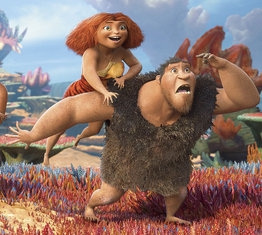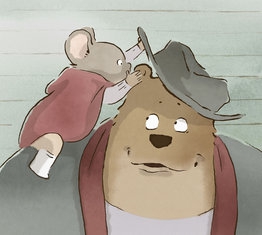Oscar Week: The Academy’s Animated Feature Oscar Nominee Symposium
It was a dark and stormy night but dry, warm and festive at the Samuel Goldwyn Theater in Beverly Hills, CA for the annual Best Animated Features Oscar Symposium. It was a chance for each of the producers and directors of the Animated Feature Nominees to showcase what went into the making of their respective film.
The event began with some remarks from a Member of the Academy’s Board of Governors for Short Films and Feature Animation Branch. He mentioned that at first the Academy had to approve of their being a category for Best Animated Feature, which was first presented in 2001. That process continued for 10 years until it became a permanent award. 2014 marks the 13th year this award will be presented.
Actor John C. Reilly, who Disney fans will remember as the voice of Ralph in the 2012 Walt Disney Animation Studios Feature “Wreck It Ralph,” hosted the Symposium and made the event entertaining and enjoyable.
The event first started with the “Let It Go” sequence from Walt Disney Animation Studios “Frozen.” “Frozen” tells the story of two sisters, Elsa and Anna, who practically live an estranged life all thanks to a secret that Elsa is keeping from Anna. Featuring the voice talents of Idina Menzel (Elsa) and Kristen Bell (Anna), the story follows their journey to become close once again following the consequences of Anna realizing who Elsa is during a ball being held at their Castle in Arendale. “Frozen” is based off the story of “The Snow Queen.”
Chris Buck, Jennifer Lee and Peter Del Vecho from “Frozen” took the stage to talk about the making of their film. Chris Buck, one of the co-directors of the film, first pitched the idea of “Frozen” in 2008 and the process took almost five years to come to life. They shared that at one point they wanted to make Elsa a villain, but moved away from that idea as the good vs. evil story has been done many times before. It was the filmmakers idea for “Frozen” to be a musical and for Elsa and Anna to be sisters after speaking with Cast Members in the Feature Animation Department. What fascinated some members of the audience was that it took nearly 14 months for “Let It Go” to be written.
And in case you didn’t know, “Let It Go,” written by Bobby Lopez and Kristen Anderson-Lopez and sung by Idina Menzel, is nominated for Best Original Song.
Following “Frozen,” it was time to showcase “The Croods.” We were shown a clip from the movie then Chris Sanders, Kirk DeMicco and Kristine Belson were brought on stage to speak about their film.
“The Croods” follows the first “modern” family as they embark on a journey of a lifetime after the cave that has always been home for them is destroyed. Traveling across a spectacular landscape, the Croods are rocked by generational clashes and seismic shifts as they discover an incredible new world filled with fantastic creatures. Their outlook is then changed forever. “The Croods” features the voice talents of Nicolas Cage, Emma Stone, Ryan Reynolds, Catherine Keener, Clark Duke and Cloris Leachman.
The film was originally developed in 2005 under the working title “Crood Awakening” as a stop motion film being made by Aardman Animations as part of a five-film deal with DreamWorks Animation. Actor John Cleese and Kirk DeMicco had been working together on a project that never went into production. The filmmakers got their inspiration for the movie from “Wallace and Gromit,” a stop-motion feature. However, it was then decided for “The Croods” to be an animated feature.
During the making of the film, there were many discussions on where in the history timeline to set “The Croods.” John C. Reilly and Producer Kristine Belson joked that kids would want to learn about the Croods in their history classes. Belson remarked that the setting for “The Croods” is “somewhere after the dinosaur era.”
Sanders, DeMicco and Belson also mentioned that the Croods are the first “real” family who has been featured in a Dreamworks animated film. By “real,” they mean that there’s a mom, dad and even a grandma who haven’t been killed off early in the film or even before the move begins.
There is also a song featured in the movie called “Shine Your Way,” which was written by Sanders and DeMicco, with help from Alan Silvestri. It was the first time that Sanders and DeMicco have ever written lyrics for a song. No word on whether they plan to continue that for a future film.
On a side note, Sanders did mention that he prefers traditional hand-drawn animation as opposed to CG animation. He almost wanted “Lilo and Stitch” to be CG but decided against it.
Now let’s see what those crazy Minions are up to as it’s time to feature “Despicable Me 2.”
After being shown a scene from the movie, we were introduced to co-directors Chris Renaud and Pierre Coffin and producer Chris Meledandri. John C. Reilly started this session by reading the Wikipedia description of the movie.
And in case you don’t know, “Despicable Me 2” is the sequel to Universal Pictures’ “Despicable Me” from 2010. The film features more Minion madness and the return of (former?) super-villain Gru, voiced by Steve Carrell, his adorable girls, the unpredictably hilarious Minions and a host of new and outrageously funny characters.
“Despicable Me” was an original story first pitched by Spanish animator Sergio Pablos, who at one time worked at Walt Disney Feature Animation.
When developing “Despicable Me 2,” the question was where the film should go. The co-directors decided on a more technical focus rather than a character development focus, which can be seen in the film.
Also of note, “Happy,” which is sung by Pharrell Williams, is nominated for Best Original Song. It was also noted that a movie featuring the Minions is in the works.
From the Minions to the story of two unexpected friends, it’s time for “Ernest & Celestine,” the first of two foreign language films nominated for Best Animated Feature. The movie is based on a series of children’s books of the same name published by Belgian author and illustrator Gabrielle Vincent.
“Ernest & Celestine” features a bear named Ernest and an orphaned mouse named Celestine who meet unexpectedly when they share an interest that leads to a bond between them that challenges the traditional enmity between their species.
After being shown a clip, co-director Benjamin Renner and producer Didier Brunner were brought up on stage to discuss their film.
During the Symposium, John C. Reilly brought up “Saving Mr. Banks” several times, and definitely made a reference to it with “Ernest & Celestine.” Why? Well, it seems that Gabrielle Vincent wanted to have the book turned into an animated feature, but similar to P.L. Travers, it took almost 20 years of convincing. Unfortunately, Vincent passed away before this was made a reality. The filmmakers were granted the rights to the book from the publisher afterwards.
In “Ernest & Celestine,” you have different worlds who learn about tolerance and compassions, and that’s exactly what the filmmakers wanted to showcase in this film. They did their best to keep to the original story without modifying too much as people in France and Belgium are familiar with this very popular story.
Renner was asked where he found his inspiration for animation and mentioned that Hayao Miyazaki was his inspiration. Renner got emotional during at this point as he couldn’t believe he was nominated in the same category as an animation legend.
Speaking of Miyazaki, it’s time to feature “The Wind Rises.” This is the second foreign language film nominated for Best Animated Film and comes to us by way of Studio Ghibli.
“The Wind Rises” tells the story of Jiro Horikoshi, a boy who dreams of someday building planes that his poor eyesight will never allow him to fly. After training as an engineer, Jiro puts his talents to work for Mitsubishi and becomes a leading innovator in aviation design, while Japan moves through the turbulent events of the 1920s and 1930s that will carry it closer to World War II.
Hayao Miyazaki was not in attendance, however, producer Toshio Suzuki took the stage to present the film.
It seems that Suzuki did not want to see a sequel to “Ponyo,” so that’s where “The Wind Rises” comes into play. Miyazaki was worried that that this movie wouldn’t appear to younger audiences based on the subject matter. But Miyazaki has a great interest in war and felt he needed to make a film based on it.
Suzuki said that most of the focus at Studio Ghibli is background art, and it certainly shows in many of their films.
Following ‘The Wind Rises” was a general question and answer session with all the filmmakers present.
During the Q&A session, “Frozen” co-director Jennifer Lee said that it’s kind of hard to please everyone when making an animated film. Others felt the same way considering it’s parents who take their kids to the movies and also want to see something that they would enjoy.
Another question posed to the panel was where they see 3D going. Some of the filmmakers mentioned that their films were designed with a 3D release in mind. However, Toshio Suzuki mentioned that 2D is the focus at Studio Ghibli and films will continue to be made in 2D “to keep the film real."
The panel was also asked for their inspiration for getting into animation. While a majority mentioned seeing a Disney classic, a few mentioned they weren’t really exposed to animation as children, which seemed to surprise several in the audience.
Overall, it was an enjoyable evening getting to know what that goes into the making of animated films and what the filmmakers had in mind.







